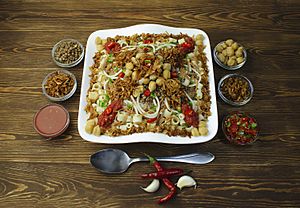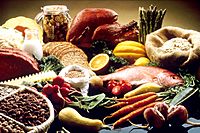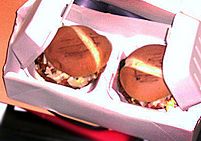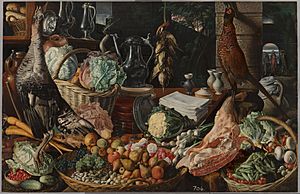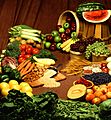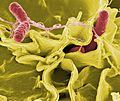Food facts for kids
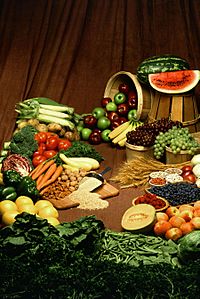
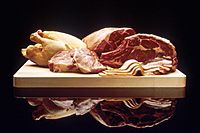
Food is what people and animals eat to live. Food usually comes from animals and plants. It is eaten by living things to provide energy and nutrition. Food contains the nutrition that people and animals need to be healthy. The consumption of food is normally enjoyable to humans. It contains protein, fat, carbohydrates, vitamins, water and minerals. Liquids used for energy and nutrition are often called "drinks". If someone cannot afford food they go hungry.
Food for humans is mostly made through farming or gardening. It includes animal and vegetable sources. Some people refuse to eat food from animal origin, like meat, eggs, and products with milk in them. Not eating meat is called vegetarianism. Not eating or using any animal products is called veganism.
| Plant source | Animal source |
| Fruit Vegetables Grains Seeds Legumes (Beans, peas, lentils, etc.) Herbs Spices |
Meat Seafood Eggs Dairy products |
Food produced by farmers or gardeners can be changed by industrial processes (the food industry). Processed food usually contains several natural ingredients and food additives (such as preservatives, antioxidants, emulsifiers, flavor enhancers). For example, bread is processed food.
Food processing at home is done in the kitchen, by the cook. The cook sometimes uses a cookbook. Examples of cooking utensils are pressure cookers, pots, and frying pans.
Food can also be prepared and served in restaurants or refectory (in particular for children in school).
The utensils used may be a plate, knife, fork, chopsticks, spoon, bowl, or spork.
Many people do not grow their own food. They have to buy food that was grown by someone else. People buy most of their food in shops or markets. But some people still grow most or all of their own food.
People may buy food and take it home to cook it. They may buy food that is ready to eat from a street vendor or a restaurant.
Production of Food
Originally, people got food as hunter-gatherers. The agricultural revolution changed that. Farmers grew crops including those invented and improved by selective breeding. These improvements, for example the invention of maize, allowed feeding more people, and further improvements gave it a better taste.
Food shortage has been a big problem throughout history. Many people do not have enough money to buy the food that they need. Bad weather or other problems sometimes destroy the growing food in one part of the world. When people do not have enough food, we say that they are hungry. If they do not eat enough food for a long time, they will become sick and die from starvation. In areas where many people do not have enough food, we say that there is famine there.
Food and water can make people sick if it is contaminated by microorganisms, bad metals, or chemicals.
If people do not eat the right foods, they can become sick.
- If people do not eat enough protein, they get the disease called kwashiorkor.
- If they do not eat enough vitamin B1 (thiamine), they get the disease called beriberi.
- If they do not eat enough vitamin C, they get the disease called scurvy.
- If children do not eat enough vitamin D, they get the disease called rickets.
People may often have a variety of eating disorders that cause them to either eat too much, or not be able to eat certain things or amounts. Common diseases like Coeliac disease or food allergies cause people to experience ill effects from consuming certain foods that are normally safe. If people eat too much food, they can become overweight or obese. This causes numerous health problems. On the other hand, eating too little food, from lack of access or anorexia could cause malnutrition. Therefore, people have to balance the amount, the nutrition, and the type of food to be healthy.
Food in religions
Many cultures or religions have food taboos. That means they have rules what people should not eat, or how the food has to be prepared. Examples of religious food rules are the Kashrut of Judaism and the Halal of Islam, that say that pig meat cannot be eaten. In Hinduism, eating beef is not allowed. Some Christians are vegetarian (someone who does not eat meat) because of their religious beliefs. For example, Seventh-day Adventist Church recommends vegetarianism.
In addition, sometime beliefs do not relate to the religion but belong to the culture. For example, some people pay respect to Guān Yīn mothergod and those followers will not consume "beef" as they believe that her father has a shape of the cow.
See also
 In Spanish: Alimento para niños
In Spanish: Alimento para niños
- Beverages
- Food science
- Native American agriculture and food
- Bush tucker
- Food processing
- Food additive
- Food group
Images for kids
-
Various raw meats
-
Salt mounds in Bolivia
-
Typical Balinese cuisine in Indonesia
-
Cooking with a wok in China
-
A traditional asado (barbecue)
-
Café Procope in Paris was founded in 1686
-
Global average daily calorie consumption in 1995
-
A tractor pulling a chaser bin
-
Packaged food aisles of supermarket in Portland, Oregon, United States of America
-
Salmonella bacteria is a common cause of foodborne illness, particularly in undercooked chicken and chicken eggs.


